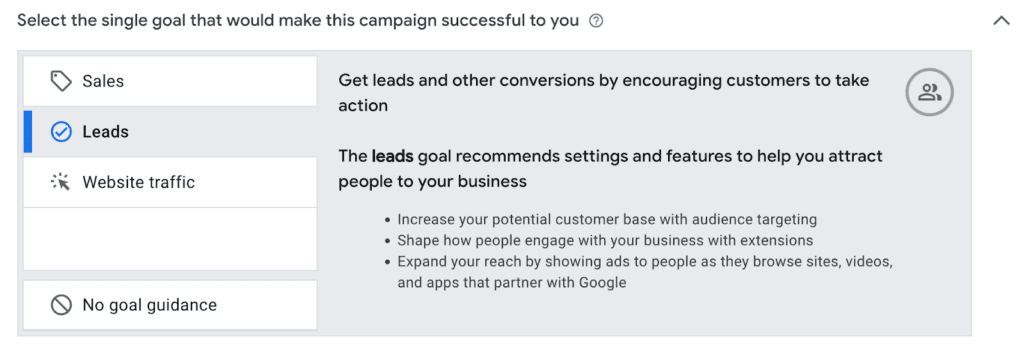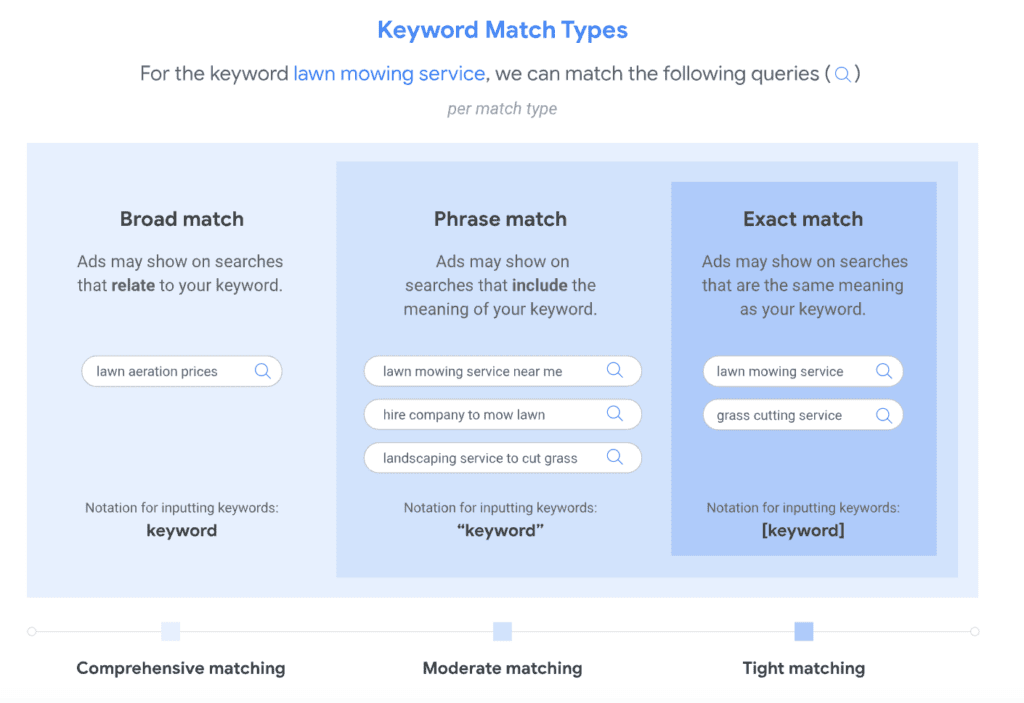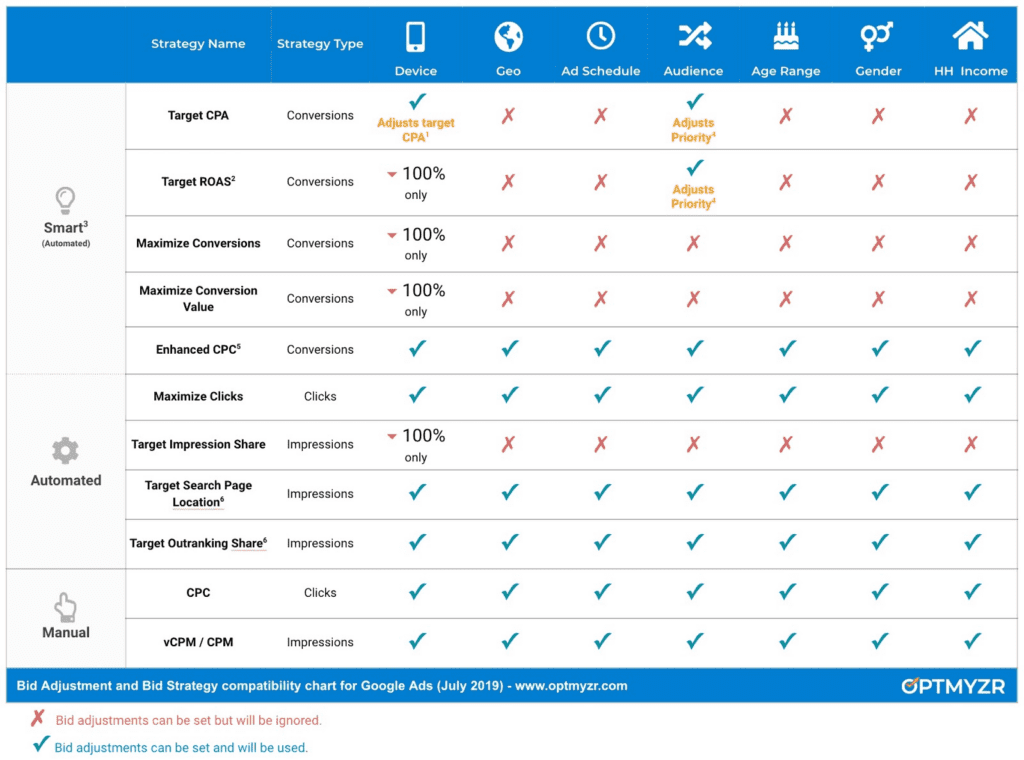Google Ads is one of the most effective ways for businesses to reach their target audience and drive conversions. With over 246 million unique visitors in the United States, it provides companies with unparalleled reach and targeting capabilities.
According to a study conducted by Wordstream, businesses that use Google Ads generate an average of $2 in revenue for every $1 spent on advertising. Additionally, those who use Google Ads see an average conversion rate of 3.75%.
Despite its effectiveness, many people make mistakes in their Google Ads campaigns that can hinder their success. In this post, we’ll explore the most common mistakes and why avoiding or fixing these mistakes is vital for success.
Mistake #1: Using default campaign settings
Understanding there are many options within the campaign settings, we will focus on a few vital ones, such as Goals, Marketing Objectives, Networks, and Bidding.
Goals
The account-default goals should apply to most of your campaigns, but there may be situations when you want more control over which conversion goals are used for bidding and reporting.
When we set up conversions for our clients, we create different values for each conversion depending on the customer journey stage. For example, a conversion within an awareness campaign may have a different value than one in the decision campaign.
Campaign-specific goal settings allow you to select the right goal for each campaign. This will give Google a clear direction for which conversion to optimize, resulting in increased conversions.

Note: All conversion actions included in a custom goal are used for reporting and bidding regardless of whether they’re set as “primary” or “secondary” goals.
Marketing Objective
When creating a campaign, you can select a marketing objective. Your objective should align with the main reason you are running the campaign, for example, Sales or Leads.

The Marketing Objective should be tied to the campaign-specific goal you selected above. For example, if you are an ecommerce store, select Sales and choose a Goal of Add to Cart or Purchase.
Networks
By default, new ad campaigns are set up to show ads across the entire network to give your ads the most visibility.

Based on our experience, we recommend NOT including Google search partners or Google Display Network.
However, you can test adding these options if you aren’t getting positive results. You can also include these options if you are in a niche industry and need to expand your reach.
Bidding
We will discuss bidding strategies later in this post, but we want to mention that the bidding strategy should coincide with the Goals and Marketing Objectives above. One example would be to have the proper Target CPA for the appropriate journey stage.

Mistake #2: Poor campaign structure
A well-built campaign structure can lead to efficient spending habits and set you up for future scalability. Although there are different aspects of a campaign, we are going to focus on the following:
- Not running the correct number of campaigns for your business
- Not establishing themes for the ad groups
- Not having the proper number of keywords in each ad group
Campaigns
Unfortunately, when it comes to the number of campaigns, it isn’t a one-size-fits-all scenario. Instead, the number of campaigns typically depends on your business objectives and budget.
For example, if you are a University in Africa, you can create Google Ad campaigns for specific sets of countries versus targeting the entire continent. This setup gives you more control over ad spending and aligns it with other organic marketing initiatives.
We recommend meeting internally and/or with your agency to establish which products or services you’d like to promote as well as the target locations. Because budget and location targeting is dictated at the Campaign level, targeting multiple locations typically equals more campaigns.
Ad Groups
Another example of having poor campaign structure in non-themed ad groups. When ad groups have too generalized keywords, writing compelling ad copy and optimizing the ad group becomes challenging, impacting your campaigns’ overall performance.
We typically theme our client’s ad groups based on their products or services.
For example, if you are a home improvement company, your ad groups can be your services, like kitchen remodeling, bathroom remodeling, etc.
This setup allows you to sync the keywords to the ads and the landing page for a seamless experience for the user, increasing the likelihood of them taking action.
Keywords
We also recommend keeping the number of keywords in an ad group to 15-25 words based on the search volume, intent, and match types (we’ll dive deeper into those in a sec).
Then, you can confirm that your keywords are relevant to your objectives and are present on the ads and the landing page.
Mistake #3: Lack of keyword diversity
A lack of diversity in keyword targeting can be detrimental to the success of your Google Ads campaign. There are a handful of ways this can manifest, but the most common examples that affect campaigns are the search volume, search intent, and different match types for keyword targeting.
Search Volume
For search volume, not having a balance of low and high-volume keywords can be one of the main reasons for lacking keyword diversity. Low-volume keywords tend to be less competitive, which means they are easier to rank for but, unfortunately, generate less traffic.
On the other hand, high-volume keywords bring in more traffic but are harder to rank since there is more competition.
We recommend mixing and matching both to increase the chances of reaching a larger audience and attracting new customers.
Search Intent
Understanding search intent is important to help align your keywords and copy with users’ needs and expectations. You may miss out on potential traffic if you don’t have a good blend of different search intent.
So, what are the different types of keywords?
From SEMRush:
Most marketers commonly agree that there are four main types of keywords to classify intent:
- Informational keywords — searchers seeking an answer to a specific question or general information.
- Navigational keywords — searchers intending to find a specific site or page.
- Commercial keywords — searchers looking to investigate brands or services.
- Transactional keywords — searchers intending to complete an action or purchase.
Regarding search intent, we recommend blending all of these in your campaigns/ad groups. However, there are also instances where you want to create more “intent-based” campaigns.
Either way, SEMRush provides a fantastic tool to help you accomplish that objective.
Match Types
Match types refer to different ways Google Ads can match search queries to keywords in your campaign. The three main types of match types are Broad, Phrase, and Exact.
Below is a chart from Google:

Broad match pushes your ads to a variation of your target keywords, including synonyms, related searches, and misspellings. Broad match type helps you find new opportunities but can show your ads to irrelevant search queries.
Phrase and Exact match allow your ads to show for searches that include the exact phrase you’ve targeted, but phrases can also include additional words before or after phrases. These two help narrow down the audience to be more specific.
Once you have identified the keywords you want to target, add them to Google using a combination of Broad, Phrase, and Exact match types.
In some cases, we start our clients with broad matches (with a strong negative list), and slowly introduce Phrases and Exact based on the performance of the keywords and search terms. It will also help monitor your keywords to see which ones are performing well and pause the ones that are not.
Mistake #4: Ignoring Search Terms Reports
One of the most important aspects of running successful Google Ads campaigns is monitoring the search terms driving clicks to the ads. Unfortunately, many businesses make the mistake of ignoring the search terms reports, leading to wasted ad spend and missed opportunities.
This mistake is particularly prevalent when using the Broad match type. While a Broad match can be a powerful tool for reaching a wide audience, it can also lead to irrelevant clicks if not monitored carefully.
By regularly reviewing the search terms report, you can ensure that the search terms driving clicks are relevant to the campaigns. This can help identify negative keywords to exclude and new keyword opportunities to add to campaigns.
In addition to avoiding wasted ad spend and identifying new keyword opportunities, regularly reviewing the search terms report can also help you understand the needs and interests of the target audience.
Mistake #5: Low-grade ad copy
Effective ad copy is crucial to the success of a Google Ads campaign.
It’s important to write compelling ad copy that is specific to the target audience and highlights the unique value proposition of the product or service. Generic, uninteresting ads are unlikely to capture the attention of potential customers, leading to lower click-through rates and conversions.
Utilizing RSAs (responsive search ads) can also help increase the performance of the ads by testing multiple headlines and descriptions. Since RSA’s introduction to the market, we’ve developed an ad structure that meets the EXCELLENT Ad Strength of Google Ads.
Although the ad creative process has multiple elements, we will focus on the Headlines today.
Below is an example of the formula we use for our clients:
- Five (5) Keyword-focused headlines
- Five (5) Unique Value Proposition headlines
- Five (5) Call-to-Action headlines
To avoid poor ad copy, follow best practices, including conducting thorough research on the target keywords and using ad copy that is unique and specific to the brand. In addition, reviewing and testing ad copy regularly helps identify areas for improvement and optimize performance.
Mistake #6: Ineffective landing page:
An ineffective landing page can significantly impact your ad campaign by lowering your Google Ads Quality Score and decreasing conversion rates. In addition, if the landing page doesn’t meet users’ expectations, they will likely leave your page quickly, resulting in a high bounce rate, lower conversion rate, and wasted ad spend.
Layout and Design
One pitfall is creating a landing page with a confusing layout or design, preventing a user from taking the desired action and lowering the conversion rate.
This could include too many navigation items, annoying popups, or the lack of call–to–action buttons.
We recommend keeping it simple.
Be clear, precise and focused on one main objective for one landing page. Keep minimal navigation that can take a user away from the landing page.
Content
When it comes to content, you want to ensure it is:
- Valuable content for the user
- Synced with ad copy and target keywords
- Has a clear call-to-action (CTA)
This would include a strong headline, your UVP (Unique Value Proposition, social proof and clear CTA.
Social proof can be in the form of reviews, testimonials, and other tools that show people validating what you say you can do for customers.
You can learn more about our landing page best practices here.
Mobile Friendly
With an increasing number of mobile users, optimizing landing pages for mobile devices is a good idea.
To optimize the landing page for mobile, make sure it is designed with mobile in mind, easy to navigate and loads quickly.
Finally, remember that all landing page elements, including images and videos, should also be optimized for mobile devices.
Mistake #7: Wrong Bidding Strategies:
Using the wrong bidding strategy can lead to wasted ad spend by overbidding on keywords, leading to higher CPC and quickly draining a campaign’s budget.
While automated bid strategies can be helpful, they come with less control over the bidding process.
Below is a quick chart provided by Optmyzr on which type of bid adjustments do or don’t affect bids when using different bid strategies.

There are numerous bidding strategies available, each with its benefits and drawbacks. Your company should explore/experiment with different bidding strategies to find the best fit for your campaigns.
Additionally, you should monitor your campaigns’ performance and adjust bidding strategies to ensure optimal results, including changing or pausing underperforming keywords or match types.
Mistake #8: Deficient Audience Targeting
One big mistake is targeting the wrong audience or not being too detailed enough with your audience targeting.
You want to understand your audience’s demographics, interests, and behaviors to make your ads reach the right people. If you do not, you lose countless opportunities to reel in customers and close sales.
Based on the type of campaign you are running, they come with different options. For example, since display ads are ALL audience-based, you have the ability to be more granular with your targeting.
For search campaigns, targeting is a combination of keywords layered with demographics. For example, these options would include Age, Gender, and Household Income.

When it comes to display, you can segment your audience based on demographics but also additional options such as Affinity, In-market, and Life Events:


Another mistake is not including retargeting campaigns in their Google ads strategy.
Retargeting allows you to show ads to users who have interacted with your website or previous ads. This technique can lead to higher conversion rates and an improved return on ad spend.
Mistake #9: Neglecting Ad Assets
Neglecting your ad assets in Google Ads can be a significant mistake for advertisers because they can help increase an ad’s visibility, provide additional information to users, and improve the overall performance of a campaign.
Various ad assets are available in Google Ads, and choosing the ones that apply to your products or services is essential.
- Sitelink extensions
- Callout extensions
- Structured snippet extensions
- Image extensions
- Call extensions
- Lead form extensions
- Location extensions
- Affiliate location extensions
- Price extensions
- App extensions
- Promotion extensions
- Automated extensions
For example, sitelink extensions are great for increasing awareness and driving traffic to specific pages on a website, while callout extensions can be used to highlight unique selling propositions or promotions.
As with the number of campaigns and bidding, this will need to be customized to your business.
If you are an ecommerce company, the Price and Promotion extensions may fit your business. Whereas a local brick-and-mortar business would want to take advantage of the Location Extension.
You should experiment with different assets and monitor their performance to determine which ones are best for you. Utilizing ad assets effectively can improve the overall performance of your Google Ads campaigns.
Mistake #10: Inadequate tracking and attribution
Tracking and attribution are critical components of any winning Google Ads campaign. Tracking will allow you to see which ads are driving results and which aren’t. Attribution gives credit for the lead, sale, or conversion to the appropriate source, such as Google or Facebook.
The biggest mistake we see is companies that aren’t tracking conversions properly.
Failing to set up conversion tracking property, not tracking all relevant conversions, or not attributing conversions to the correct campaigns can make or break your campaign’s success.
One effective way to track data is by using UTM parameters. These parameters can help track the source, medium, campaign, term, and content of a user’s visit to your website.
We typically break down data into two categories:
- Pre-click data: Cost, Impressions, Clicks, CTR, and CPC
- Post-click data: Conversions, Conversion Rate, and Cost per Conversion.
By fixing tracking and attribution mistakes and implementing best practices, you can make decisions that eliminate wasted ad spend and maximize return on investment.
Conclusion
To summarize, avoiding these common mistakes is essential when creating and running Google Ads campaigns.
The most significant mistakes include but are not limited to using poor account structure, lack of keyword diversity, and failing to track and attribute conversions.
The good news is that many of these can be avoided by developing a thoughtful, detailed ad strategy before launching new campaigns.
Ongoing campaign optimizations are also a must-do to keep up with changes in the market and monitor their ads’ performance to make data-driven decisions.
Good luck out there!

